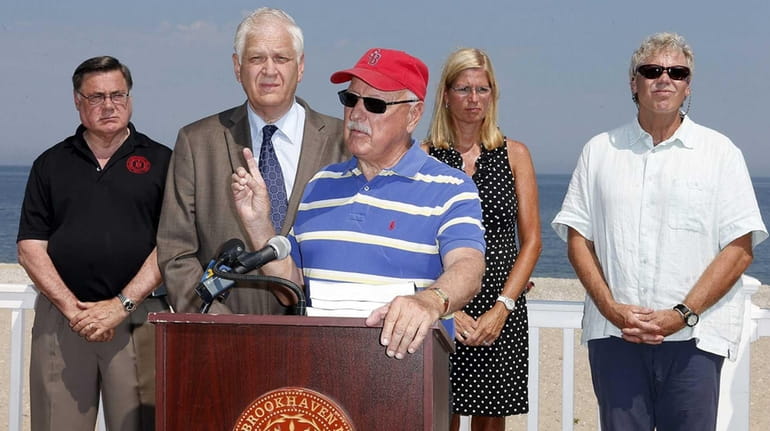Stop dredge dumping in LI Sound

New York State Senator Ken LaValle (center), along with, from left to right, Town of Brookhaven Supervisor Ed Romaine, Rep. Steve Englebright, Brookhaven Councilwoman Jane Bonner and environmentalist Kevin McAllister appear at a press conference together at Cedar Beach in Mt. Sinai on Monday, Aug. 17, 2015. Credit: Joseph D. Sullivan
Any short list of what makes Long Island special includes the Long Island Sound. It's our North Shore playground, a place for recreation and for commerce. It's where we swim and boat and fish, and on its shores we contemplate its beauty.
But we have not treated it kindly through the years, dumping into it all sorts of muck that has degraded the water and helped kill much of what lives in it. Lately, we've been making amends, with sensible steps to try to reverse the degradation. That's what makes so disappointing a new federal plan to allow the continued dumping of millions of cubic yards of dredge spoils from Connecticut into the Sound. It's an ill-advised proposal that needs to be rejected and reformulated.
Let's be clear: Connecticut's harbors and rivers do require periodic dredging to keep them passable for marine traffic. For decades, the dredged muck has been dumped at four sites in the Sound. Some is toxic, with heavy metals such as cadmium and copper. The rest also does damage -- clouding the water, consuming oxygen, blocking sunlight and killing bottom-dwelling organisms as it falls to the Sound floor.
Ten years ago, the Army Corps of Engineers proposed to keep two sites with expiring permits open for 20 more years and dump 20 million more cubic yards of dredge spoils. In the battle royale that ensued, New York Gov. George Pataki blocked the plan and an agreement was signed by New York, Connecticut, the Army Corps and the Environmental Protection Agency to have the Corps craft a new plan with alternatives to dumping. But this new version doubles down on dumping -- 50 million cubic yards over 30 years -- and rejects alternatives as too costly. That's unacceptable.
Open-water dumping is cheaper in the short run, true. But given the environmental damage it causes, it should be the option of last resort. And identifying alternatives, and using them, would reduce their cost. There are many examples of dredge spoils being put to good use. Elsewhere, dredged material has helped restore 40 acres of tidal wetlands in Jamaica Bay, reconstruct a California golf course and cap landfills like the Fresh Kills behemoth in Staten Island. As for toxic materials, they can be treated and sent to a hazardous-waste landfill.
Progress in restoring the Sound has been made by improving sewage treatment in both states. Dolphins are frolicking again, beluga whales were spotted this spring, and bait fish seem more abundant. But there's a long way to go. Parts of the Sound, especially in the western end, are still dead zones and many fisheries have yet to rebound. Dumping 50 million more cubic yards of dredge spoils will make any further restoration that much more difficult.
Two New York State departments already have informed the Army Corps of their concerns. Now Gov. Andrew M. Cuomo must summon his inner environmental Pataki and kill the proposal. Then the Corps needs to do what it was charged with doing 10 years ago: Come up with ways to stop the dumping into Long Island Sound, and reclaim the waterway that is so much a part of our heritage.
